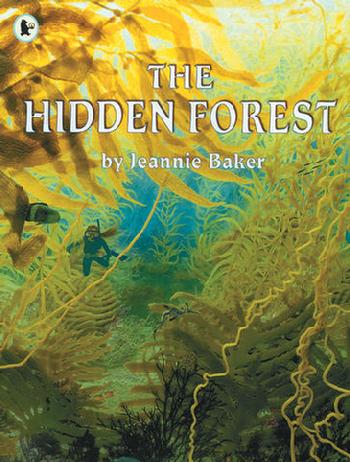 |
| Publisher: Greenwillow Books |
|
Our Winning Book Synopsis:
This is the story of a rather thoughtless boy named Ben who sets out to simply exploit a bay of the sea for fish. Unexpectedly, he gets his fish trap stuck on the sea floor, and ultimately, he ends up learning all about a hidden forest, and valuing the community of the marine organisms that live beneath his fishing dinghy. What an eye-opening day for Ben!
How does Ben's underwater environmental and botanical education occur? It begins when his friend Sophie, who is a strong diver, agrees to help him free his trap. She is his guide into the always beautiful, and forever undulating world of the kelp forest. Along the way, Ben finds his venture into this strange submerged world occasionally frightful, yet totally fascinating. (See if you can spot what makes Ben fearful even before Ben does!)
Jeannie Baker's striking visual panoramas, set above and below the water level, as well as from the shore and from the boat, help children gain multiple and additive views of a threatened marine environment located along the coast of Tasmania.
The story is composed of lean and staccato prose, falls occasionally speechless, and is at once primal, experiential, emotional, and life-changing. This is a bonafide tale with two characters that a young child can "become." It's embedded with plant science and marine science learning opportunities, so it's not another pedantic, preachy, mini-textbook. (For example, just by careful observation across Jeannie Baker's pages, one can see that as kelp grows, a blade at the tip of each frond separates, producing a series of tiny new blades.)
Ms. Baker meshes the narrative text with large, visually tactile, naturally illuminated, double-page artwork with success that only a solo artist-illustrator could achieve. Her book also silently invites its "child-participants" to begin a quest to identify a visual variety of organisms seen on the pages by consulting marine science reference sources--in books or on-line. Less can be more, and this rather minimalist book evokes searching and questioning, rather than smothering it.
|